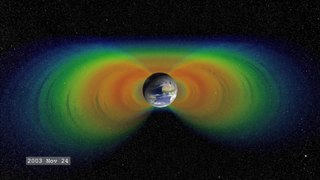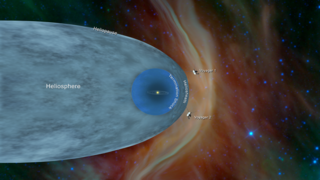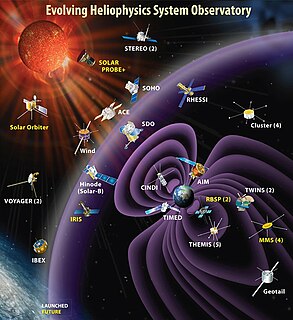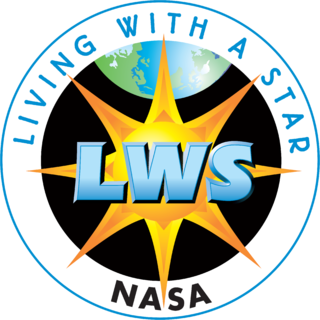Related Research Articles

The solar wind is a stream of charged particles released from the upper atmosphere of the Sun, called the corona. This plasma mostly consists of electrons, protons and alpha particles with kinetic energy between 0.5 and 10 keV. The composition of the solar wind plasma also includes a mixture of materials found in the solar plasma: trace amounts of heavy ions and atomic nuclei C, N, O, Ne, Mg, Si, S, and Fe. There are also rarer traces of some other nuclei and isotopes such as P, Ti, Cr ,Ni, Fe 54 and 56, and Ni 58,60,62. Embedded within the solar-wind plasma is the interplanetary magnetic field. The solar wind varies in density, temperature and speed over time and over solar latitude and longitude. Its particles can escape the Sun's gravity because of their high energy resulting from the high temperature of the corona, which in turn is a result of the coronal magnetic field.

A solar flare is a sudden flash of increased brightness on the Sun, usually observed near its surface and in close proximity to a sunspot group. Powerful flares are often, but not always, accompanied by a coronal mass ejection. Even the most powerful flares are barely detectable in the total solar irradiance.

A Van Allen radiation belt is a zone of energetic charged particles, most of which originate from the solar wind, that are captured by and held around a planet by that planet's magnetic field. Earth has two such belts and sometimes others may be temporarily created. The discovery of the belts is credited to James Van Allen, and as a result, Earth's belts are known as the Van Allen belts. Earth's two main belts extend from an altitude of about 640 to 58,000 km above the surface in which region radiation levels vary. Most of the particles that form the belts are thought to come from solar wind and other particles by cosmic rays. By trapping the solar wind, the magnetic field deflects those energetic particles and protects the atmosphere from destruction.

The heliosphere is the vast, bubble-like region of space which surrounds and is created by the Sun. In plasma physics terms, this is the cavity formed by the Sun in the surrounding interstellar medium. The "bubble" of the heliosphere is continuously "inflated" by plasma originating from the Sun, known as the solar wind. Outside the heliosphere, this solar plasma gives way to the interstellar plasma permeating our galaxy. Radiation levels inside and outside the heliosphere differ; in particular, the galactic cosmic rays are less abundant inside the heliosphere, so that the planets inside are partly shielded from their impact. The word "heliosphere" is said to have been coined by Alexander J. Dessler, who is credited with first use of the word in scientific literature in 1967. The scientific study of the heliosphere is heliophysics, which includes space weather and space climate.

The Solar Orbiter (SolO) is a planned Sun-observing satellite, under development by the European Space Agency (ESA). SolO is intended to perform detailed measurements of the inner heliosphere and nascent solar wind, and perform close observations of the polar regions of the Sun, which is difficult to do from Earth, both serving to answer the question "How does the Sun create and control the heliosphere?"
Solar physics is the branch of astrophysics that specializes in the study of the Sun. It deals with detailed measurements that are possible only for our closest star. It intersects with many disciplines of pure physics, astrophysics, and computer science, including fluid dynamics, plasma physics including magnetohydrodynamics, seismology, particle physics, atomic physics, nuclear physics, stellar evolution, space physics, spectroscopy, radiative transfer, applied optics, signal processing, computer vision, computational physics, stellar physics and solar astronomy.

STEREO is a solar observation mission. Two nearly identical spacecraft were launched in 2006 into orbits around the Sun that cause them to respectively pull farther ahead of and fall gradually behind the Earth. This enables stereoscopic imaging of the Sun and solar phenomena, such as coronal mass ejections.

The Solar Dynamics Observatory (SDO) is a NASA mission which has been observing the Sun since 2010. Launched on February 11, 2010, the observatory is part of the Living With a Star (LWS) program.

The Time History of Events and Macroscale Interactions during Substorms (THEMIS) mission began in February 2007 as a constellation of five NASA satellites to study energy releases from Earth's magnetosphere known as substorms, magnetic phenomena that intensify auroras near Earth's poles. The name of the mission is an acronym alluding to the Titan, Themis.

Heliophysics is the science of the Sun and the physical connections between the Sun and the solar system. NASA defines heliophysics as "(1) the comprehensive new term for the science of the Sun - Solar System Connection, (2) the exploration, discovery, and understanding of Earth's space environment, and (3) the system science that unites all of the linked phenomena in the region of the cosmos influenced by a star like our Sun. Heliophysics concentrates on the Sun, and its effects on Earth, the other planets of the solar system, and the changing conditions in space. Heliophysics is concerned with the magnetosphere, ionosphere, thermosphere, mesosphere, and upper atmosphere of the Earth and other planets. Heliophysics combines the science of the Sun, corona, heliosphere and geospace. Heliophysics encompasses cosmic rays and particle acceleration, space weather and radiation, dust and magnetic reconnection, nuclear energy generation and internal solar dynamics, solar activity and stellar magnetic fields, aeronomy and space plasmas, magnetic fields and global change, and the interactions of the solar system with our galaxy."

Living With a Star (LWS) is a NASA scientific program to study those aspects of the connected Sun-Earth system that directly affect life and society. LWS is a crosscutting initiative with goals and objectives relevant to NASA's Exploration Initiative, as well as to NASA's Strategic Enterprises. The program is managed by the Heliophysics Science Division of NASA's Science Mission Directorate.

The Van Allen Probes, formerly known as the Radiation Belt Storm Probes, were two robotic spacecraft that were used to study the Van Allen radiation belts that surround Earth. NASA conducted the Van Allen Probes mission as part of the Living With a Star program. Understanding the radiation belt environment and its variability has practical applications in the areas of spacecraft operations, spacecraft system design, mission planning and astronaut safety. The probes were launched on 30 August 2012 and operated for seven years. Both spacecraft were deactivated in 2019 when they ran out of fuel. They are expected to deorbit during the 2030s.

Parker Solar Probe is a NASA robotic spacecraft launched in 2018, with the mission of repeatedly probing and making observations of the outer corona of the Sun. It will approach to within 9.86 solar radii from the center of the Sun and by 2025 will travel, at closest approach, as fast as 690,000 km/h (430,000 mph), or 0.064% the speed of light.

Energetic neutral atom (ENA) imaging, often described as "seeing with atoms", is a technology used to create global images of otherwise invisible phenomena in the magnetospheres of planets and throughout the heliosphere, even to its outer boundary. This constitutes the far-flung edge of the solar system.

The Heliophysics Science Division of the Goddard Space Flight Center (NASA) conducts research on the Sun, its extended solar system environment, and interactions of Earth, other planets, small bodies, and interstellar gas with the heliosphere. Division research also encompasses geospace—Earth's uppermost atmosphere, the ionosphere, and the magnetosphere—and the changing environmental conditions throughout the coupled heliosphere.

The Interstellar Mapping and Acceleration Probe(IMAP) is a heliophysics mission that will simultaneously investigate two important and coupled science topics in the heliosphere: the acceleration of energetic particles and interaction of the solar wind with the local interstellar medium. These science topics are coupled because particles accelerated in the inner heliosphere play crucial roles in the outer heliospheric interaction. In 2018, NASA selected a team led by David J. McComas of Princeton University to implement the mission. The planned launch for IMAP is in October 2024. IMAP will be a Sun-tracking spin-stabilized satellite in orbit about the Sun–Earth L1 Lagrangian point with a science payload of ten instruments. IMAP will also continuously broadcast real-time in-situ data that can be used for space weather prediction.
NASA's Solar Terrestrial Probes program (STP) is a series of missions focused on study the Sun-Earth system. It is part of NASA's Heliophysics Science Division within the Science Mission Directorate.
Polarimeter to Unify the Corona and Heliosphere (PUNCH) is a future mission by NASA to study the unexplored region from the middle of the solar corona out to 1 AU from the Sun. PUNCH will consist of a constellation of four microsatellites that through continuous 3D deep-field imaging, will observe the corona and heliosphere as elements of a single, connected system. The four microsatellites are planned to be launched in 2023, along with a pair of secondary satellites named Tandem Reconnection and Cusp Electrodynamics Reconnaissance Satellites (TRACERS).
Tandem Reconnection and Cusp Electrodynamics Reconnaissance Satellites (TRACERS) is a planned orbiter mission tasked to study the origins of the solar wind and how it affects Earth.
References
- 1 2 Synergies of Orbiter & Probe+ (2009)
- ↑ "Living With a Star missions". Living With a Star. Archived from the original on 2007-07-17. Retrieved 2007-08-12.

